Imagine you're cruising on a Ducati, and suddenly the engine overheats, leaving you stranded. This scenario highlights one of many potential engine issues you might face with iconic Italian motorcycles. From timing belt failures to fuel injector clogs, these problems can disrupt your riding experience and pose serious risks. You'll want to understand the common signs and symptoms of these issues to keep your bike in top shape. What other engine troubles could be lurking beneath the surface of your beloved machine?
Key Takeaways
- Overheating is common in Ducati engines, often due to inadequate cooling systems or extreme riding conditions, requiring regular coolant checks.
- Timing belt failures can cause power loss, strange noises, and engine warning lights, necessitating regular inspections and maintenance.
- Fuel injector issues may lead to inconsistent performance, strong gasoline smells, and poor fuel economy, indicating the need for cleaning or replacement.
- Oil leaks often arise from worn gaskets and degraded seals, emphasizing the importance of regular maintenance to identify and address leaks early.
Ducati Engine Overheating
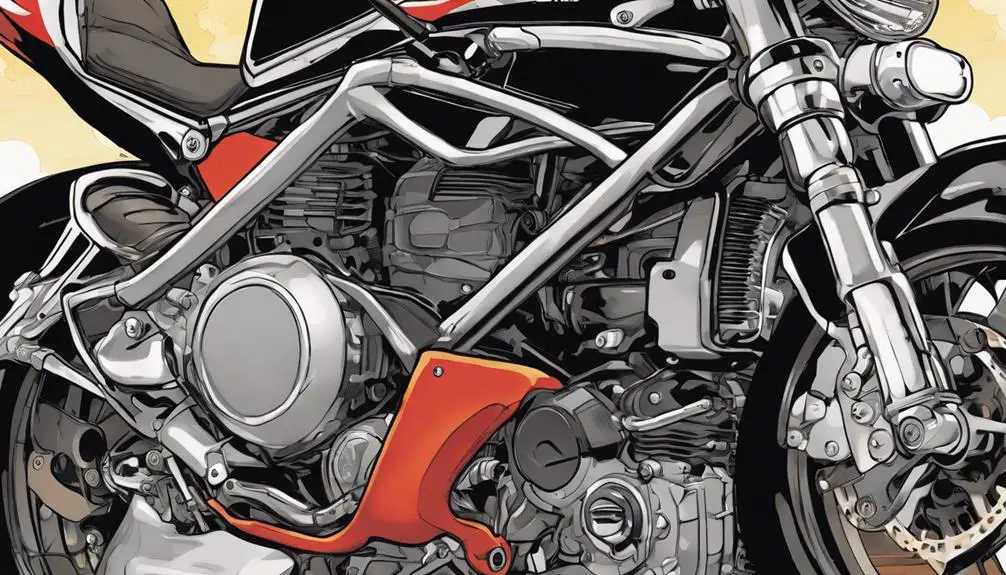
Ducati engines can overheat due to inadequate cooling systems or riding conditions, leading to potential performance issues. When you ride, you want to feel the thrill of freedom that only a powerful machine can provide. However, if your engine runs too hot, you risk losing that exhilarating experience.
To prevent overheating, you should regularly check your coolant levels and inspect the radiator for any blockages. If you're pushing your Ducati to its limits, be mindful of the environment. High temperatures, stop-and-go traffic, or riding at low speeds can all contribute to overheating.
Don't ignore warning signs, like an unusual temperature gauge reading or steam rising from the engine. If you notice any of these, pull over and let your bike cool down.
Embrace your ride by keeping your Ducati in top condition. A well-maintained engine not only enhances your performance but also amplifies your sense of liberation on the road.
Timing Belt Failures
When you're riding your Italian motorcycle, timing belt failures can sneak up on you.
You need to know the symptoms, so you can catch issues early and avoid costly repairs.
Regular maintenance is key to keeping your timing belt in top shape and ensuring a smooth ride.
Symptoms of Failure
Timing belt failures can manifest through a range of symptoms, making it essential for you to recognize them early to prevent severe engine damage. One of the first signs you might notice is an unusual noise coming from the engine. This could be a high-pitched whine or a grinding sound, indicating that the belt isn't functioning properly.
Pay attention to any sudden loss of power or rough idling; these could signal that your timing belt is slipping or has become misaligned. You may also observe fluctuations in your engine's speed or performance. If your motorcycle hesitates during acceleration or struggles to reach higher RPMs, it's a red flag.
Additionally, if the check engine light flickers or remains illuminated, don't ignore it. This warning often points to timing-related issues. Lastly, if your bike has developed an oil leak at the front of the engine, it's vital to investigate. Timing belt failures can lead to oil seal damage, risking further complications.
Prevention and Maintenance
Regular inspection of your motorcycle's timing belt can greatly reduce the risk of failures and extend the life of your engine. You want your ride to roar with power, not sputter to a halt. Keeping an eye on that timing belt is key to maintaining your freedom on the road.
Here are some essential tips for timing belt prevention and maintenance:
- Check regularly: Inspect the belt for signs of wear, cracks, or fraying at least every 5,000 miles.
- Replace on schedule: Follow the manufacturer's guidelines for belt replacement—don't push your luck!
- Keep it clean: Dirt and grime can cause premature wear, so wipe down the belt during regular cleanings.
- Monitor engine temperature: Overheating can stress the belt. Keep an eye on your gauges to prevent overheating issues.
Valve Adjustment Problems
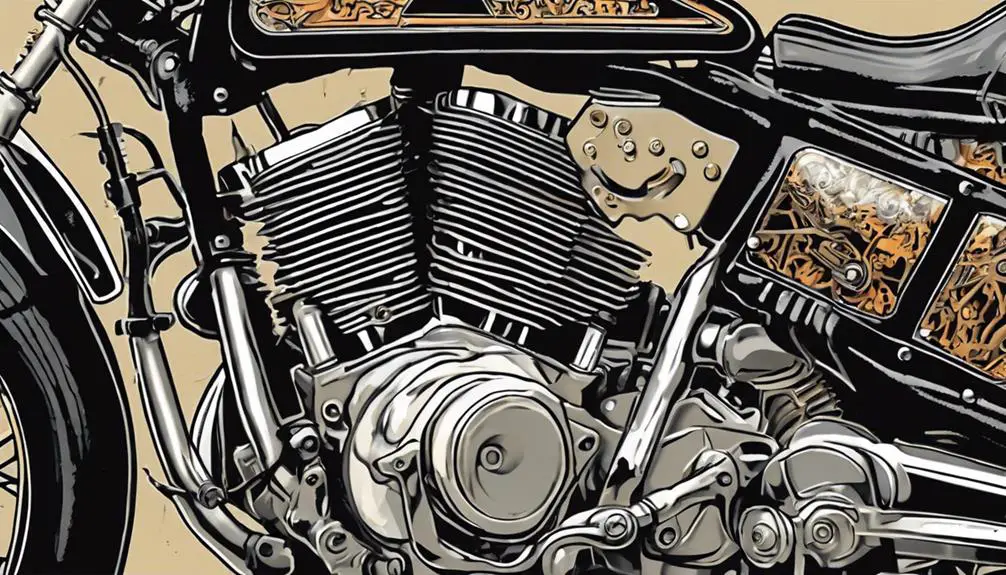
Valve adjustments can lead to significant performance issues in Italian motorcycles if not done correctly. You might find that your bike's engine loses power, produces strange noises, or runs hotter than normal—all signs that your valves may be out of spec. When you ignore these adjustments, you're not just risking performance; you're also compromising the very essence of freedom that riding offers.
To achieve peak performance and release your motorcycle's true potential, you've got to stay on top of valve adjustments. Start by checking the service manual for your specific model to find the correct clearance specifications.
If you're unsure, don't hesitate to consult an experienced mechanic who knows the ins and outs of Italian machines.
Fuel Injector Issues
Fuel injectors play an essential role in delivering the right amount of fuel to your Italian motorcycle's engine, and any malfunction can lead to performance headaches. If you notice a dip in power, poor fuel economy, or even rough idling, your fuel injectors might be the culprits.
Here are some common signs that your fuel injectors need attention:
- Inconsistent Engine Performance: Stuttering or hesitation during acceleration can indicate clogged injectors.
- Fuel Smell: A strong odor of gasoline around your bike often points to leaking injectors.
- Increased Emissions: If you see more smoke than usual, your injectors might be delivering too much fuel.
- Poor Fuel Economy: If you're stopping at the pump more often, it's time to check your injectors.
Don't let fuel injector problems hold you back from the freedom of the open road.
Regular maintenance and timely repairs will keep your iconic Italian motorcycle performing at its best, allowing you to enjoy every moment of your ride without worry.
Oil Leak Concerns
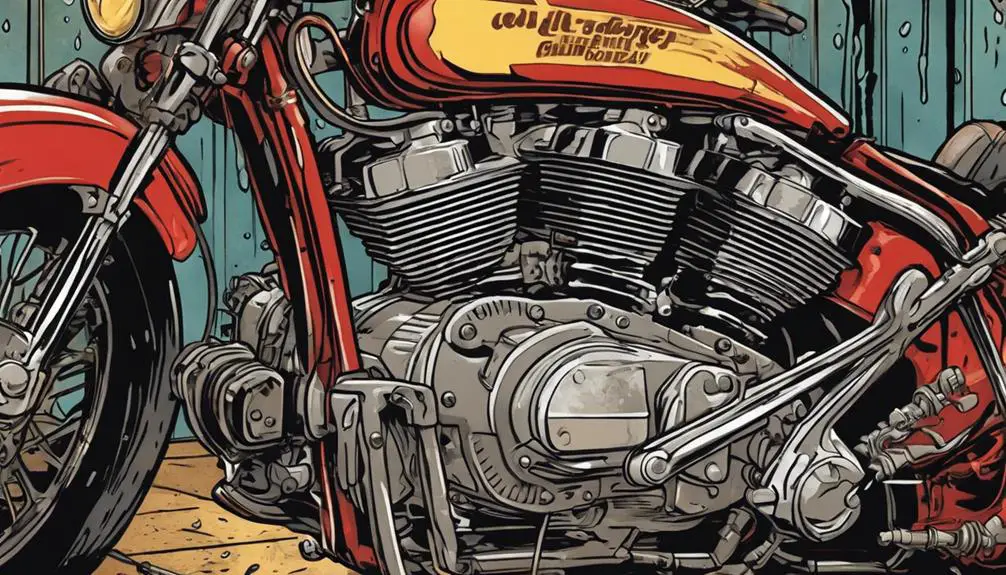
Oil leaks can be a frustrating issue for any motorcycle owner, especially with Italian bikes.
You need to know the common causes of these leaks and how to prevent them through regular maintenance.
Let's explore how you can keep your bike running smoothly and avoid costly repairs.
Causes of Oil Leaks
Italian motorcycles often develop oil leaks due to worn gaskets, loose fittings, or degraded seals that fail to keep fluids contained. These issues can lead to frustrating ride interruptions and unwanted stains on your garage floor. It's crucial to know what's causing these leaks so you can enjoy the freedom of the open road without worry.
Here are some common causes of oil leaks you might encounter:
- Worn Gaskets: Over time, gaskets can lose their ability to seal properly.
- Loose Fittings: Vibration can cause fittings to loosen, leading to leaks.
- Degraded Seals: Rubber seals can harden and crack, allowing oil to escape.
- Old Oil: Using old or contaminated oil can break down seals and gaskets.
Prevention and Maintenance Tips
Regular maintenance and inspections can greatly reduce the risk of oil leaks in your motorcycle. You'll want to keep a close eye on the oil levels and quality, changing it regularly based on your manufacturer's recommendations. Using high-quality oil and filters can help maintain peak performance and seal integrity.
Check the gaskets and seals for wear or damage. If you notice any cracks or degradation, replace them immediately. Pay attention to any unusual stains or puddles beneath your bike—these often signal leaks that need addressing. Don't forget to inspect your oil lines and connections for any loose fittings, as these can lead to leaks if not tightened.
Cleaning your engine regularly can also help you spot leaks early. A clean engine allows you to identify oil spots that might go unnoticed in a greasy environment.
Electrical System Malfunctions
When dealing with electrical system malfunctions in motorcycles, you might notice issues like flickering lights or intermittent starting problems. These frustrating experiences can disrupt your ride and lead you to question your bike's reliability.
To tackle these issues, keep an eye out for common signs of electrical trouble:
- Battery Drain: If your battery drains faster than expected, it could signal a deeper electrical issue.
- Corroded Connections: Rust or corrosion can interrupt power flow, causing erratic behavior.
- Faulty Wiring: Damaged or frayed wires can lead to shorts, making your bike unpredictable.
- Blown Fuses: A blown fuse might seem minor, but it often indicates an underlying problem that needs addressing.
Clutch Slippage Symptoms
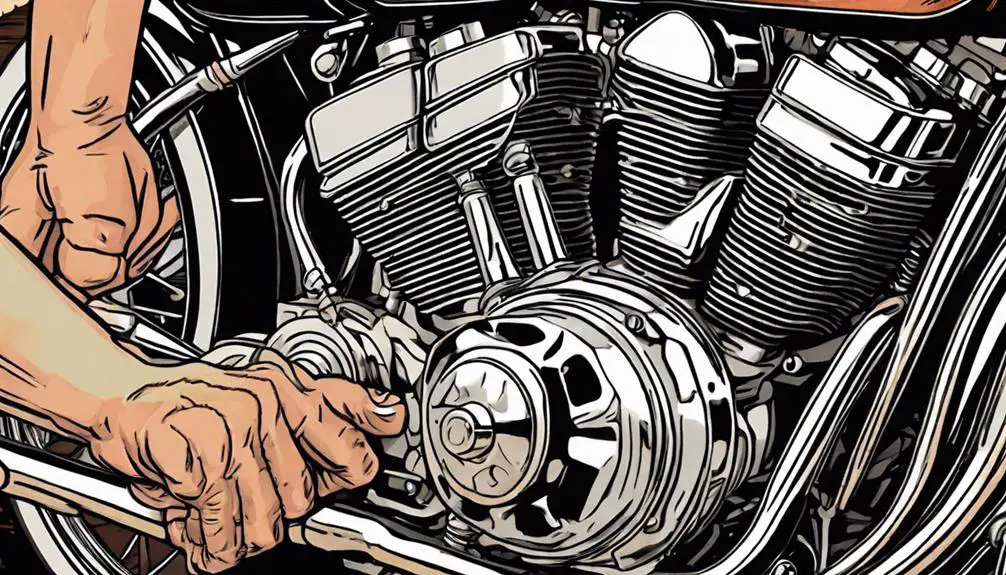
You may notice clutch slippage if your motorcycle struggles to accelerate or if the engine revs up without a corresponding increase in speed. This symptom can feel like a loss of power, leaving you frustrated as you chase the freedom of the open road. When you twist the throttle, you expect the bike to respond enthusiastically, but slippage can make it feel like you're stuck in molasses.
Another telltale sign is a burning smell, often resembling burnt toast, which occurs when the clutch plates overheat. If you hear unusual sounds when shifting gears, like a grinding noise, it's a clue that something's amiss. You might also feel the clutch lever engage differently, perhaps requiring more effort than usual to pull, which can hinder your riding experience.
Keep an eye on your RPMs, as they can rise without a significant increase in speed. If you're feeling these symptoms, it's time to act. Addressing clutch slippage not only guarantees your ride remains thrilling but also helps maintain the liberating spirit of your Italian motorcycle. Don't let clutch issues hold you back; reclaim your ride!
Gearbox Noise and Troubles
If you're hearing unusual noises from your gearbox, it could signal underlying issues that need attention.
Understanding the common causes of gearbox noise can help you take action before things worsen.
Plus, we'll share some preventive maintenance tips to keep your motorcycle running smoothly.
Causes of Gearbox Noise
Identifying the causes of gearbox noise can help prevent further damage and guarantee a smoother ride on your Italian motorcycle. These noises can stem from a variety of issues, and it's vital to pinpoint them to maintain your freedom on the road. Here are some common culprits:
- Worn Gear Teeth: Over time, gears can wear down, leading to grinding noises.
- Low Gearbox Oil: Insufficient lubrication can increase friction and create unsettling sounds.
- Faulty Bearings: Damaged or worn-out bearings can cause rattling and excessive noise.
- Misaligned Components: If gears aren't properly aligned, it can result in clunking and grinding.
Being aware of these causes helps you take charge of your bike's performance. Ignoring gearbox noise can lead to more significant issues, ultimately hindering your riding experience.
Preventive Maintenance Tips
Regularly checking and maintaining your motorcycle's gearbox can considerably reduce the risk of noise and other troubles. To keep your ride smooth and free from annoying sounds, start by inspecting the oil level and quality. Fresh oil lubricates the gears effectively, so change it according to your manufacturer's recommendations.
Next, pay attention to the gearbox's alignment. A misaligned gearbox can create unnecessary strain, leading to noise and wear. If you notice any abnormal sounds while riding, don't ignore them! Get to the root of the issue before it escalates.
Don't forget to inspect the gears and bearings for signs of wear. If you feel any roughness when shifting, it's time to address that. Regularly tightening loose bolts and checking for any leaks can also help maintain your gearbox's integrity.
Lastly, consider using a high-quality gear oil designed for your bike, as this can enhance performance and prolong lifespan. By being proactive and committed to your motorcycle's health, you'll enjoy the freedom of the open road without worrying about gear troubles. Embrace the ride, and keep that gearbox in top shape!
Performance Deterioration Signs
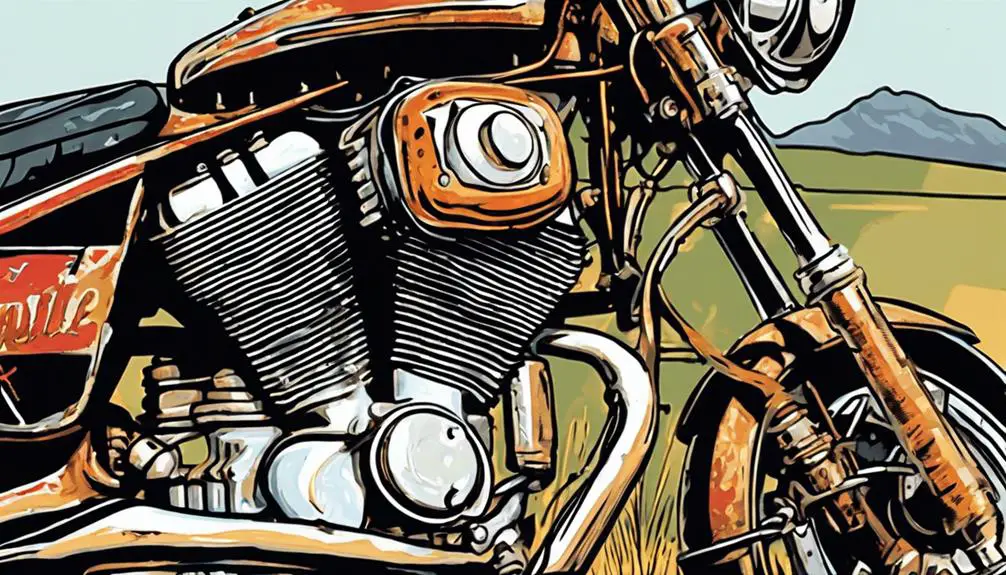
Noticeable changes in throttle response and unusual vibrations can signal performance deterioration in your Italian motorcycle. When you feel these shifts, it's time to pay attention. Your ride should deliver a smooth, exhilarating experience, and any disruption can take away that freedom you crave.
Here are some signs to watch for:
- Increased Engine Noise: If your engine sounds louder or different, it might be time to investigate.
- Stalling Issues: Frequent stalling can indicate underlying engine problems that need addressing.
- Poor Fuel Efficiency: A sudden drop in miles per gallon is a red flag.
- Difficulty Starting: If your bike struggles to start, it could signal a deeper issue.
Embrace the joy of riding by staying vigilant about these signs. Your Italian motorcycle deserves the best care to keep it roaring down the road.
If you notice any of these issues, don't hesitate to dive deeper. Your journey of liberation on two wheels should never be compromised!
Common Misfire Causes
Have you ever experienced a frustrating misfire while riding your Italian motorcycle? It can feel like a betrayal from your trusted machine, leaving you yearning for that unshackled ride. Misfires often stem from a few common culprits.
First, check your spark plugs. Worn or fouled plugs can disrupt the ignition, causing that jarring stutter. You might also want to inspect your fuel system. Clogged fuel filters or dirty injectors can choke your engine, leading to uneven power delivery.
Another sneaky cause is a faulty ignition coil, which can send your bike into a fit of misfires. Don't overlook the air-fuel mixture as well; an imbalance can lead to inefficient combustion.
Frequently Asked Questions
What Are the Best Maintenance Practices for Italian Motorcycle Engines?
To keep your Italian motorcycle engine running smoothly, you should regularly check and change the oil, ensuring it's clean and at the right level.
Keep an eye on the air filter, replacing it as needed, and don't forget to inspect the spark plugs for wear.
Regularly tighten bolts and inspect the cooling system to prevent overheating.
How Can I Prevent Engine Issues in My Italian Motorcycle?
Your Italian motorcycle deserves the royal treatment, and preventing engine issues is the key to keeping it purring like a lion on the open road.
Regularly check your oil levels and change the oil as recommended. Keep the air filter clean, and don't forget to inspect the spark plugs.
Staying on top of routine maintenance will help you ride freely without fear of breakdowns. Remember, a little care goes a long way!
What Tools Are Essential for Diagnosing Engine Problems?
To diagnose engine problems effectively, you'll need a few essential tools.
Start with a multimeter for electrical issues, a compression tester for checking cylinder pressure, and a diagnostic scanner for reading error codes.
Having a set of wrenches and screwdrivers is vital for any mechanical adjustments.
Don't forget a good flashlight to see those hard-to-reach areas.
With the right tools, you're empowered to take control of your motorcycle's health and performance.
Are There Specific Oils Recommended for Italian Motorcycle Engines?
When you think about the heart of your Italian motorcycle, the oil you choose is essential.
Imagine that silky liquid coursing through its veins, keeping everything smooth and free.
For these beauties, synthetic oils, like 5W-40 or 10W-50, are often recommended for their performance.
They provide that liberation you crave, enhancing power while protecting your engine.
How Often Should I Service My Italian Motorcycle's Engine?
You should service your Italian motorcycle's engine every 3,000 to 5,000 miles, or at least once a year, whichever comes first.
Regular maintenance keeps your ride smooth and reliable, allowing you to embrace the freedom of the open road.
Don't ignore the signs; if you notice any unusual sounds or performance drops, get it checked sooner.
Staying proactive guarantees your bike stays as spirited as your desire for adventure!
Conclusion
Maintaining your iconic Italian motorcycle is like nurturing a fine Italian dish; every ingredient must be just right for the perfect ride.
By staying vigilant about common engine issues—like overheating, timing belt failures, and fuel delivery problems—you can keep your bike running smoothly.
Don't let minor problems simmer into major headaches. Regular maintenance and prompt attention to signs of trouble will guarantee your motorcycle remains a thrilling companion on every journey.
Keep the passion alive!